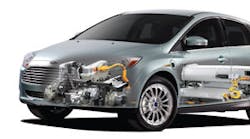Such systems permit energy to be transferred from a source that is placed on or under the ground to a vehicle that is equipped with an energy-capture device. Charging occurs automatically when the vehicle is parked. No physical contact is needed between the vehicle and the charging source.
WiTricity has already developed and brought to market its patented magnetic-resonance wireless charging system. The company claims that its system can transfer energy further and more efficiently than conventional systems, such as those based on electromagnetic induction and microwave transmission. In fact, it enhances the possibility of wireless charging by being able to deliver charging power to 3.3 kW over a distance of 20 cm (almost 8 in.) at an efficiency rate of more than 90%. The Witricity system plants the coil and condenser in both the transmitter and receptor. It transmits power when the transmitter's magnetic resonance is synchronized with the receptor. (the company likens this process to a singer who shatters a wine glass by projecting just the right sound.) This charging system provides freedom when considering a charging structure, as the transmitter and receptor can function at various angles instead of just top and bottom.
Through this partnership, the companies plan to make easily deployable wireless charging systems for EVs over three steps: research and development, real-world testing, and commercialization. In the first step, they will find the most appropriate and easiest ways to incorporate wireless charging systems into the EV charging infrastructure. Next, they will have to clarify legal matters regarding the new technology and create proposals for rules governing the use of such systems. Finally, they will test wireless charging systems with EVs that are internally fitted with power-charging receptors.
The three companies are combining wireless charging technology; electric-power-infrastructure know-how; and over four decades of EV research, development, and technology. The partnership structure of three major players in the wireless charging, electric infrastructure, and EV areas coming together will accelerate the popularization of wireless charging systems for EVs developing systems that are usable "right out of the box" for individuals, governments, and other entities (including power companies). This capability will make it easier and quicker for them to roll out such systems.

